EngageMedia Blog
Ahu Parmalim and Religious Tolerance
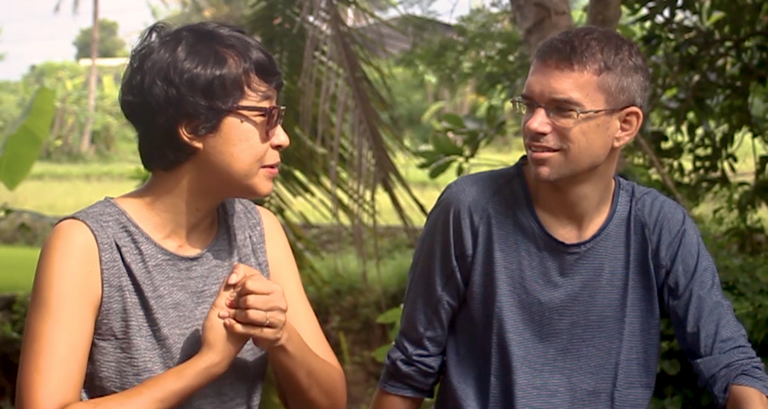
Ahu Parmalim is a short documentary film by Indonesian foundation Kampung Halaman. Founded in 2006 in Yogyakarta, Kampung Halaman offers a space for young people to learn and understand the potential and challenges within their own environments through media. Kampung Halaman focuses on young Indonesians, whom they invite to make video diaries. These diaries are participatory video processes, facilitated by more experienced video-makers, and rely more on the process, than end-results. Final videos are screened locally, followed by discussions with stakeholders. Kampung Halaman runs an online video depot where hundreds of video diaries are archived and made available.

Ahu Parmalim translates to: ‘I am a Parmalim’ in Batak, the local languages spoken by the Batak people in Northern Sumatra. The short documentary follows 17-year-old Carles Butar Butar going about his daily life in Northern Sumatra. Carles is a Parmalim, an active follower of the Malim religion (Ugamo Malim). Viewers are acquainted with the religious practices of Ugamo Malim and get to know Carles as a friendly, diligent and intelligent young man. He is well respected, performs above average in school, and is highly devoted to his religion, family, and his country. Notwithstanding his simple background, his parents are farmers earning just enough to survive, Carles, dreams of becoming a policeman. Through Carles inquiries, we also learn that believing in ‘the one true God’ is a mandatory condition for becoming a policeman in Indonesia.
Every Indonesian citizen is free to choose his/her religion, a right clearly stated in article 28E of the Indonesian constitution. Nonetheless, minority groups and adherents of indigenous beliefs, such as Ugamo Malim, have always been subject to discrimination. They have to struggle not only to receive recognition and protection from the state but also to gain equal access to various public services. Carles’ case is no different. “We learned that Carles was rejected to join the Indonesian Police because he was not a follower of one of Indonesia’s main religions” explains Chandra, manager of education and technology at Kampung Halaman.
This simple, yet intriguing short documentary, made on the sidelines of facilitating video dairies with teenagers in North Sumatra, has been able to open up discussions in Indonesia about religious freedom and tolerance. Ahu Parmalim premiered on International Tolerance Day (16 November 2017) at 40 locations across Indonesia simultaneously. Within three months it was screened over one hundred times. As we near the end of 2018, Kampung Halaman still receives requests for screening. Ahu Parmalim has been screened and discussed all over Indonesia, in Australia, Malaysia and toured briefly in the USA. Initially, screenings took place through network organizations of Kampung Halaman. Hosts received a screening guide and various one-minute animations movies (2 examples of which can be seen at the start of this video) were prepared to introduce and provide background information on key topics.
A special website (in Indonesian) collects past and upcoming screening dates and locations, gives background information, has an online form to collect screening reports and documentation, while those interested in hosting a screening can send in their request here.
After initially posting the film online, Kampung Halaman decided to take it offline and only share it directly with those interested. “We were doubtful that just counting hits would allow us to measure any real impact of the film,” Chandra explains. “The fact that Ahu Parmalim has vastly surpassed its initial goal of twenty screenings and the many comments we are getting from screenings are better indicators for its impact.”
The success of Ahu Parmalim is in part due to national events, occurring completely out of the film-makers control. A ‘landmark ruling’ by Indonesia’s constitutional court, late 2017, officially affirmed the rights of devotees of faiths outside Indonesia’s official recognized religions. From now on these devotees no longer required to identify as either Muslim, Catholic, Protestant, Hindu, Buddhist or Confucian on their national identification cards. This decision and the media whirlwind it stirred in Indonesia provided tremendous momentum for Ahu Parmalim, with many audiences seeking to understand what these ‘alternative faiths’ actually entail. The timing of the release of Ahu Parmalim could therefore not have been better. The director of the film, Cicilia Maharani, acknowledges this fact:
“We are grateful that finally, the film found its own audiences. The discussions after the film screenings created a better understanding of local religion believers like Carles.”
Watch an interview with Cicilia Maharani, the director of the film “Ahu Parmalim”.
Tales from The East Horizon, Revisited
We called it “Tutur Ufuk Timur”, which means Tales From the East Horizon. It is a series of screenings and discussions of videos from Papua initiated by Papuan Voices (PV), EngageMedia and a number of local organisations. The roadshow traveled across six cities in Java from 17 to 26 November 2018, screening mainly films from previous iterations of the Festival Film Papua (FFP).
On 17 November, we began our journey from the west side of Java in Jakarta, Indonesia’s capital. From there, we traveled to an area which much higher altitude: Bandung; co-organising a screening on the 19th with AKATIGA. In the succeeding days, particularly on the 20th and 21st, we were able to have screenings and discussions at the Pusat Studi Sejarah dan Etika Politika (Center for Historical Studies and Political Ethics) at the Universitas Sanata Dharma in Central Java. Much to our delight, we were received with a good number of audience. We then arrived in Semarang on the 24th for an event at the Hall of Santa Theresia Church in Bongsari. Next, we moved to Solo for another event in Rumah Banjarsari on the 25th.
We culminated the tour on the 26th by organising an event in Teater LTC (Learning Training Center) at the Universitas Kristen Satya Wacana in Salatiga. Collectively, around 250 students, researchers, film-makers, clergymen, journalists and human rights and environmental activists.

For a long time, the story of Papua, particularly West Papuan provinces, has been disseminated to other parts of Indonesia through images and narratives produced by state-owned and private broadcasting and print media institutions. To add, West Papua has a few independent media outfits that produce featured films, documentaries and visual news reports, but they do not have enough reach. Through mobile film screenings and discussions we have organised across cities in Java, the aim of EngageMedia and PV was to change the perception of ordinary Indonesians towards the struggles of residents of Papua and West Papuan provinces. In addition, these sessions served as a platform in strengthening external communication capacity of the PV community in order to reach a wider audience.
As we go travel from one city to another, we witnessed the enthusiasm of young people in fighting for social justice and the environment, especially in Papua. Thus, we believe that these screenings and discussions provided the best platform for the PV community to capture feedback, criticism, and suggestions on their work directly from its audience.
Since its inception, films produced by the PV community have been used primarily as media advocacy tools in campaigning about environmental and social justice for West Papua. Previously, EngageMedia and PV have collaborated with other communities that also include educators and researchers. Now, due to its evident potential, EngageMedia and the PV community have been collaborating in organising training programs in Papua to teach filmmaking to local youths.
In 2017, the PV community successfully hosted the first independent film festival ever to be held in Papua: the Papuan Film Festival. It was considered as a benchmark for the film movement in the area. In fact, documentary films that were screened during the festival encouraged young Papuan film-makers to continue producing films that show their struggles as a Papuan and a human being. In addition, the storytelling tradition of their indigenous community helps those who were able to watch their documentaries in sharing its stories with wider and more remote communities. We believe that this also builds awareness among communities on various events, past and present, in a dialectical nature. Moreover, it contributes to the collective effort of discussing civil, political, economic, social and cultural rights of indigenous peoples; and helps initiate a movement towards environmental sustainability for future generations.
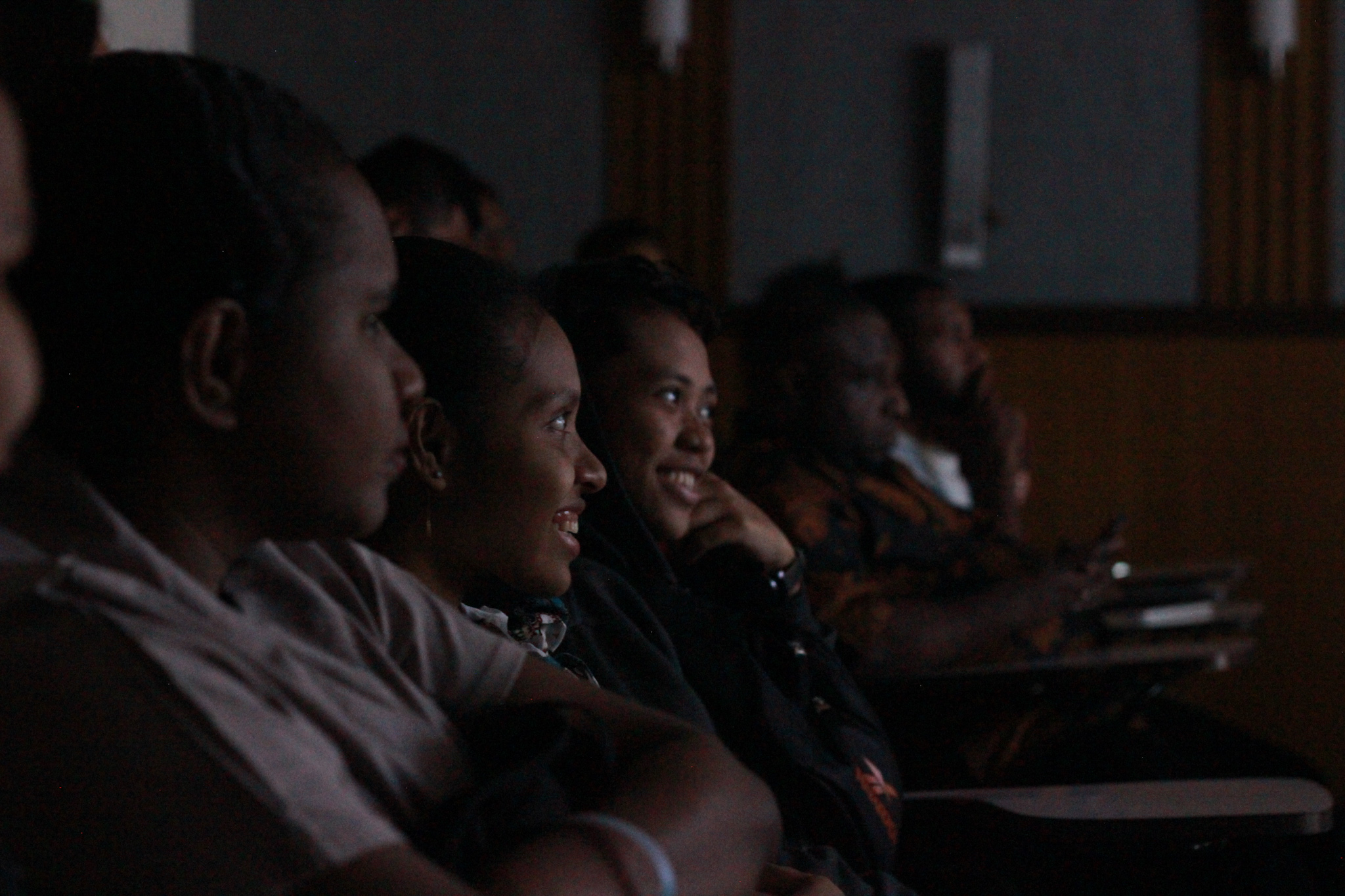
The second Papuan Film Festival was held in August this year in Jayapura, Papua. With the theme, “Indigenous Papuans Struggling in the Face of Modernisation”, the festival aimed to increase public awareness on critical issues faced by the indigenous Papuans; and emphasise their role in economic and infrastructural developments in the region.
During the “Tutur Ufuk Timur” roadshow, the majority of the audience who came to watch the films were young educated Indonesians who have daily interactions with colleagues from Papua and West Papua. Papuan students who live in the cities along the roadshow’s itinerary actively participated in the discussions to provide additional context for the films being screened. We are continuously trying to organise this project because we believe that what hinders regulatory and political changes in Papua and West Papua are not institutional issues; but the biased reporting of the mass media that involves discriminatory narratives, intervening and suspecting political expressions as a threat to our national security. This harmful framing continues to be augmented by intolerant groups acting on behalf of the greater Indonesian society.
We sincerely hope that initiatives such as “Tutur Ufuk Timur” will create more platforms for the Indonesian civil society wherein they are able to discuss and understand the real struggles of those in Papua and West Papua.
Engaging South East Asian Film Festivals
From October to December of 2018, EngageMedia went to five Southeast Asian film festivals to share its learnings on social issue documentaries, impact distribution, digital security and Video for Change.
 Filmmakers and activists who attended the Video for Change Discussion in the
Filmmakers and activists who attended the Video for Change Discussion in the Freedom Film Festival - Mending the Gaps
First stop was the 2018 edition of Freedom Film Festival (FFF) in Kuala Lumpur, Malaysia last October. Now on its 15th year, FFF is the biggest human rights-oriented film festival in Southeast Asia. Highlighted this year were the Orang Asli or indigenous peoples of Malaysia; who in the past years have been battling the encroachment of big business in what remains of their ancestral domain. Film screenings, performances and various discussions depicting their situation were held throughout the film festival.
 Melawan Arus traces the undercurrents beneath the waves that swept
Melawan Arus traces the undercurrents beneath the waves that sweptMeanwhile, the closing film Melawan Arus by Arul Prakkash documented the power shift from The United Malays National Organisation to Parti Pribumi Bersatu as narrated by veteran Malaysian activists. The intense discussion during the open forum that followed after the screening reflected the overall feeling of Malaysians prevalent during the duration of the festival--that of desiring to push for as much change that is possible under the new political situation.
Here is an interview of Anna Har and Brenda Danker of the Freedom Film Network we published last year where they talked in details about the 2018 festival "Mending The Gaps".
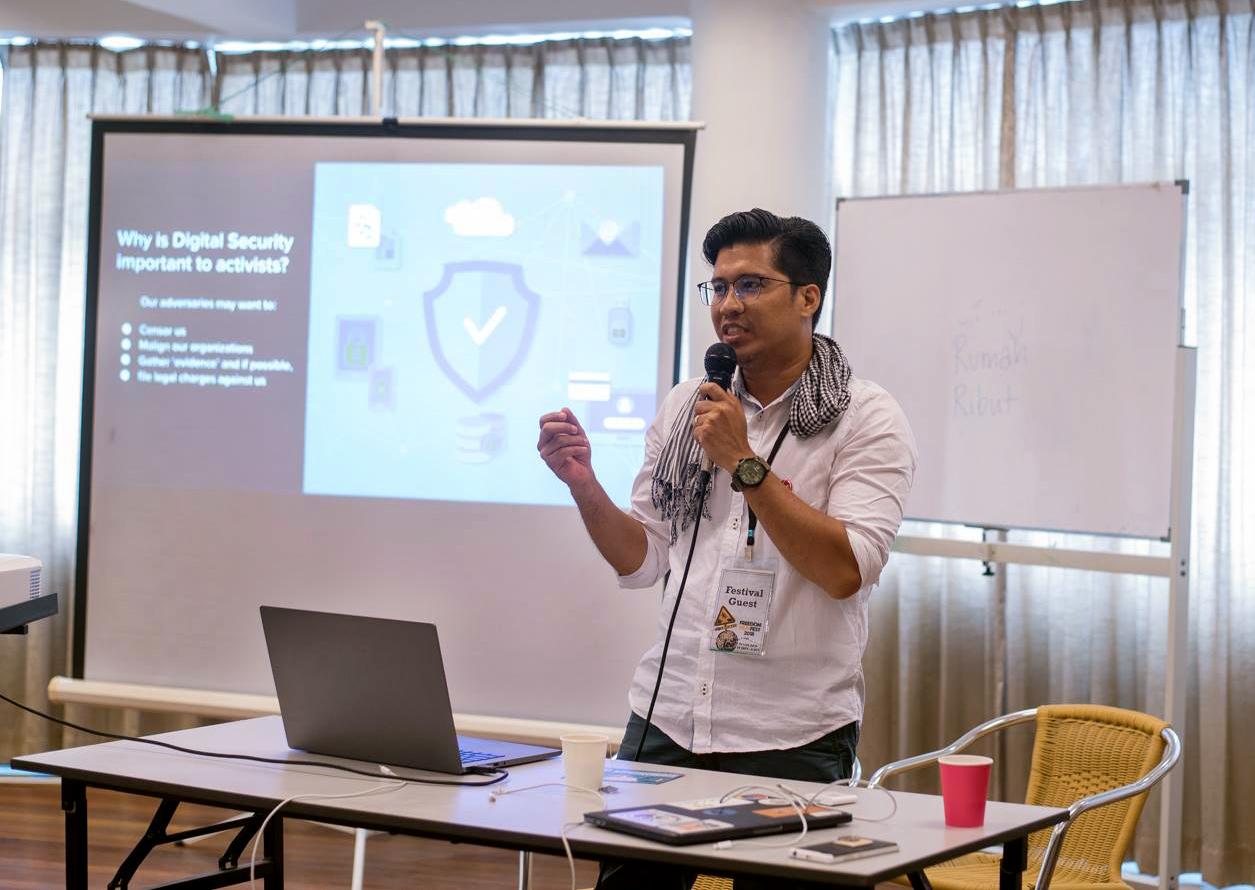 During a session with the Freedom Film Network, EngageMedia featured its advocacy in using Video for Change; particularly in its initiatives in West Papua and Papua region in Indonesia and through the Video4Change Network.
During a session with the Freedom Film Network, EngageMedia featured its advocacy in using Video for Change; particularly in its initiatives in West Papua and Papua region in Indonesia and through the Video4Change Network.
After the screening of Black Code, a documentary on the global impact of the internet on free speech, privacy and activism, EngageMedia co-facilitated a Digital Activism Workshop with WITNESS Asia. It explored online privacy and the right to expression, and how to best utilise video, mobile phones and technology for digital advocacy.
13th Jogja-NETPAC Asian Film Festival
The Jogja-NETPAC Asian Film Festival was founded in Yogyakarta in 2007. It is one of the initiatives of the Network for the Promotion of Asian Cinema (NETPAC), a worldwide organisation founded in 1990 to promote greater understanding and appreciation for Asian films and filmmakers. It has presented the prestigious NETPAC Award for Best Asian Film at 30 film festivals in various countries throughout the world, such as Berlin, Rotterdam, Warsaw, Moscow, Jeonju, Busan and Hawaii.

EngageMedia was invited to the 13th Jogja-NETPAC Asian Film Festival with “Disruption” as its central theme. During the festival, several special screenings, discussions, public lectures and educational sessions took place in various venues across Yogyakarta. On the 30th November, EngageMedia’s Pitra Hutomo and Egbert Wits organised a community forum on social impact and video for change for an audience of about 40 film-makers, activists and students. Read more about it here.
Active Vista International Human Rights Film Festival
Amidst Philippine President Rodrigo Duterte’s war on drugs, misogyny and attacks against his critics, the sixth of the Active Vista International Human Rights Film Festival was launched in Manila last 26 November 2018. This year’s theme, “Imagination”, sheds light on the real stories of human rights struggles despite the dark cloud of disinformation and hate dividing many Filipinos.
 We're holding a session on #Video4Change for #ActiveVista Film Workshop in QC, Philippines as part of #AVHRF2018 #AVFest2018 pic.twitter.com/CUc7GwIqoN
We're holding a session on #Video4Change for #ActiveVista Film Workshop in QC, Philippines as part of #AVHRF2018 #AVFest2018 pic.twitter.com/CUc7GwIqoNEngageMedia facilitated a Video for Change session in the Active Vista Film Workshop, a workshop series that integrates human rights and art advocacy into filmmaking. Attended by young and vibrant filmmakers from various backgrounds, the session was culminated by the collective realisation on the need for more impact distribution efforts of filmmakers, film producers and civil society in the Philippines.
29th Singapore International Film Festival
Fourth stop is the longest-running and largest film event in the Little Red Dot, the Singapore International Film Festival (SGIFF). The festival was widely attended by international film critics who are on the lookout for local and regional talent, as well as emerging trends in Asian cinema. Parallel events like masterclasses, fora and panel discussions hosted by the most prominent personalities of Asian cinema provided opportunities for emerging filmmakers to expand their horizons and to see what is in demand in the sphere of contemporary film festivals.
EngageMedia led a session entitled “Social Issue Documentary and Impact” in SGIFF Connects, a networking session where organisations can hold talks and preview new works. It was attended by an audience of different backgrounds including students, filmmakers and civil society.
It highlighted the idea of Impact Pathway; and the Values and Methods of Video for Change, two key concepts in the Impact Handbook which will soon be released by EngageMedia and Video4Change Network.
Past SGIFF Connects collaborators include Netflix and the Motion Picture Association of America.
Press Pause Luang Prabang
The Luang Prabang International Film Festival is emerging as one of the most significant film festivals in Southeast Asian; but, the organisers were not able to secure a permit from the Lao government last December 2018.Nevertheless, we attended PAUSE, a festival with film screenings, cultural exchanges, and more, which were freely accessible to the public.

If public screening of films like Edmund Yeo’s We the Dead and and Anucha Boonyawatana's Malila: The Farewell Flower had pushed through, the projection would have been a beautiful complement to the unique architecture of the UNESCO Heritage Site of Luang Prabang.

EngageMedia’s Executive Director Andrew Lowenthal and Video4Change Coordinator King Catoy were two of the panel members of the Film and Social Change Discussion.
They had the opportunity to share their past learnings on the subject matter. King shared the experiences of alternative media groups in the Philippines in filming marginalised sectors; as well as these films’ impact on both online and offline discourses about the worsening human rights situation in the Philippines.
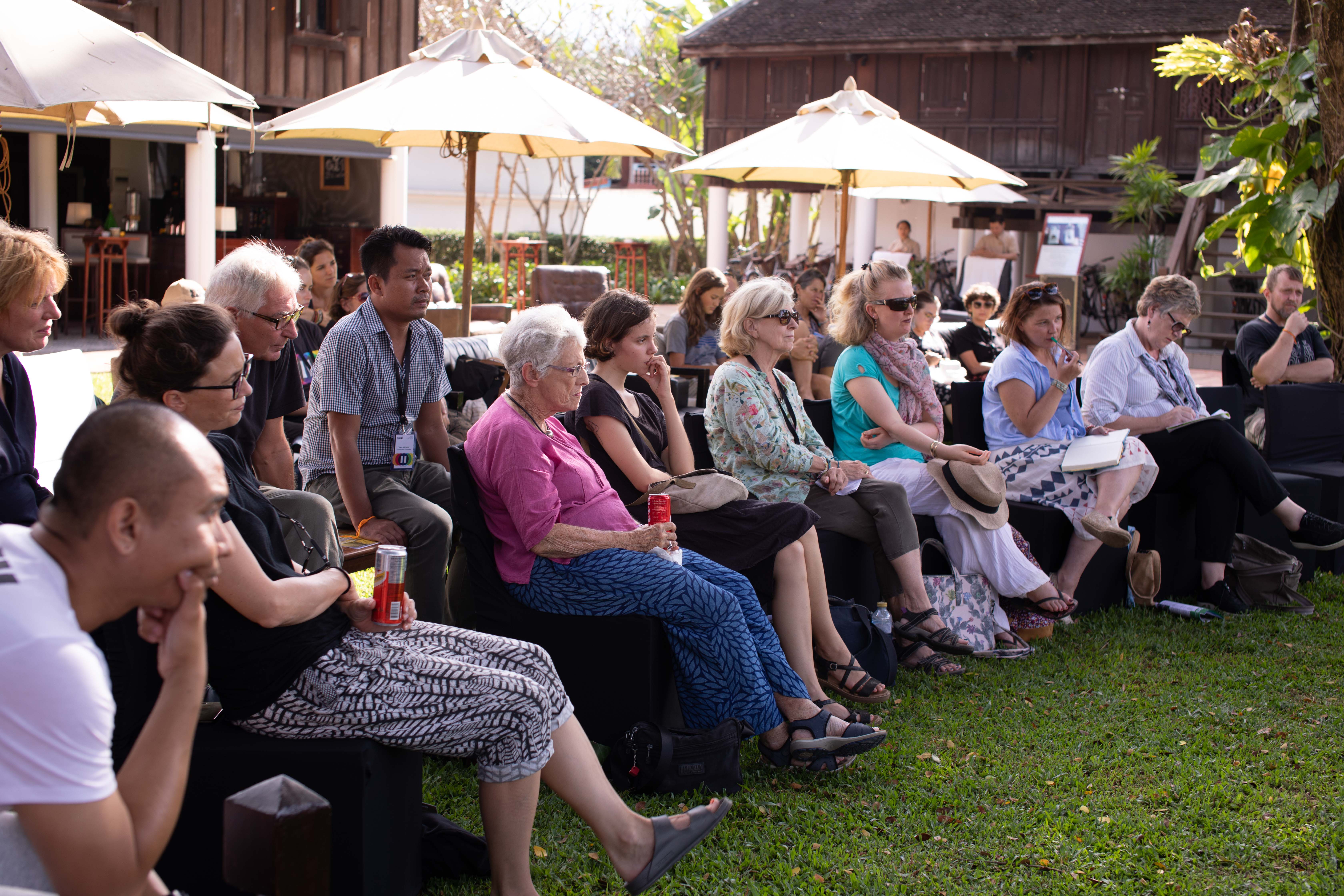
Andrew, for his part, reiterated the role of video in bringing positive change to affected communities facing discrimination, and other issues in the context of EngageMedia’s work.
Reflection
The last four film festivals written here took place within an exhilarating period of two weeks. We had the unique opportunity to see the most relevant films from the region, and even meet some of the filmmakers behind them. It was also an occasion to meet up and coming filmmakers looking for possible collaborators outside the commercial industry who are willing to share their cinematic vision.
Lastly, it was a moment to meet the festival directors, visionaries who see films as not just another blockbuster hit or bust, but rather as artistic statements that reflect the good and the bad of contemporary Asian life and times. Tiring as the journey had been, EngageMedia would not miss a similar chance to do this again in the future.
Accessible Ways to Measure Online Censorship

Cases of Online Censorship in Southeast Asia
In 2017, a game called Fight of Gods was blocked by the Malaysian Communications Multimedia Commission (MCMC), as it is a “[t]hreat to the sanctity of religion and interracial harmony in the country”. Similarly, both Malaysian and Indonesian governments were found to be blocking FanFiction.Net, due to its contents’ homesexual and erotic nature.
Without announcements or justification from the government, it would be difficult to figure out if censorships are being done. We have seen numerous examples of governments’ campaigns against certain types of content that violate their laws and/or values. But how vulnerable is this power to censor content to abuse?
In 2017 as well, 161 websites was banned by the Indonesian government, which included sites that cater to the LGBT community, an independent news outlet based in the United States and a blog that features criticism for the current government. No news, no anything from the government. However, using one tool, Indonesians learned that their access is being controlled by the government.
While there are more sophisticated and time-consuming strategies to measure censorship, Tor Project, which is in the forefront of censorship circumvention and privacy-centric initiatives, developed a much simpler tool that can be used by anyone around the world: the Open Observance Network Interference (OONI) Probe. This very tool helped in realising and validating the censorship of 161 active websites in Indonesia.

What is OONI
Formulated in 2012, OONI is a “free software [and] global observation network for detecting censorship, surveillance and traffic manipulation on the internet.” As freedom of speech and censorship on digital platforms are relatively new concepts, there are little to no tools that can measure blocking. Unlike traditional censorships in form of shutdowns, similar to the recently ended powering down of TV stations in Kenya, that can be immediately observed with the lack of aired shows and news on TV, journalists and advocates did not have any capacity or knowledge of a tool that would help in proving instances of online censorships in seemingly democratic countries. OONI ultimately aims to answer this.
What OONI Does
In order to do this, OONI runs the probe daily using a working test list of pertinent websites mainly identified by CitizenLab. Each country has its own working test list, which can be downloaded and updated by anyone who is interested. The probe tests censorship per internet subscription or network, as one website can be censored in one, and be completely accessible in another. This is extremely helpful in uncovering and analysing rationales behind every censorship, may it be to hinder the public to in receiving information or due to hidden corporate interests.

OONI Probe Mobile App
In their desire to operate the probe holistically and involve a much wider set of stakeholders, OONI also developed a mobile app which is available both on Android and iOS devices, which is more accessible and easier to use for the common people. With the prominence of messaging apps such as Facebook Messenger and WhatsApp, the app can be easily used to see if a network blocks access to these apps. Moreover, like a bonus feature, the app also has the capacity to conduct a speedtest. These accessibility features resulted to more people using the app and contributing to the fight for freedom of speech and right to information.
EngageMedia and OONI
EngageMedia continues to explore how it can maximize existing initiatives like OONI to the strengthening of digital rights advocacy in the region. This year, EngageMedia sent a representative to attend a regional workshop on testing and collecting evidence of network interference organised by Sinar Project. This workshop participation led to a small-scale collaboration project of doing baseline probe testing & analysis in the Philippines. [Keep posted to the Link of the Report on the Testing].
Opportunities for Collaboration
OONI, as a platform, is a relatively young initiative and is not without faults. In fact, there were a few instances where evidences of censorship were false positives. It is still in continuous development and needs all the help it can get. Anyone who is willing to contribute to testing and/or finalising test lists can do so by contacting OONI directly at contact@openobservatory.org.
EngageMedia on Video for Change and social impact in Yogyakarta

EngageMedia- Yogyakarta was invited at the 13th Jogja-NETPAC Asian film festival. which took place from 27 November to 4 December, with “Disruption” as its central theme. During the festival, several special screenings, discussions, public lectures and educational sessions took place in various venues across Yogyakarta. On the 30 November, EngageMedia’s Pitra Hutomo and Egbert Wits organised a community forum on social impact and video for change for an audience of about 40 film-makers, activists and students.
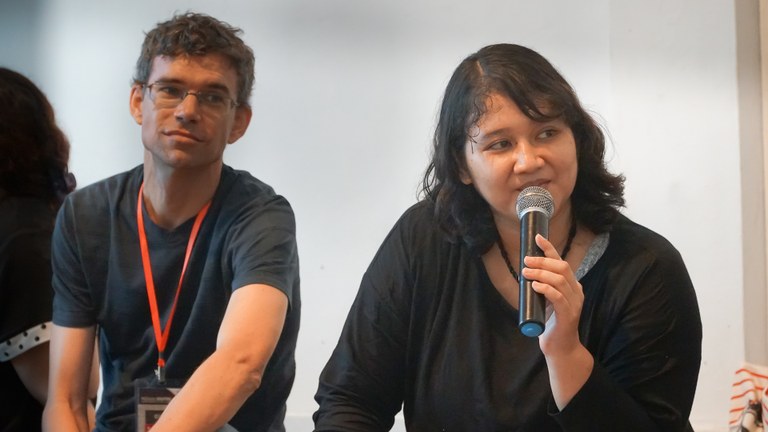
Pitra launched the forum by introducing EngageMedia and the variety of activities the organisation initiates or has been involved in. She introduced the Papuan Voices program, which has enabled local youth from Papua to tell their stories via documentaries and films. Mama Mariode (2018), a short film from the 2nd Papuan Film Festival (2018), was screened to provide a glimpse of the initiative. The film featured indigenous woman Mariode discussing environmental issues in West Papua and was met with great enthusiasm. It also received a heartwarming applause from the audience.

After which, Egbert then introduced the Video4Change network and EngageMedia’s involvement in the network’s research on social issue documentary and impact. In particular, he shared various aspects of the Impact Pathway, a concept which helps film-makers, activists, individuals and organisations working with video on how to design for and evaluate social impact(s). Through relatable Indonesian films, the audience was familiarised with different types of social changes that can be achieved through video.
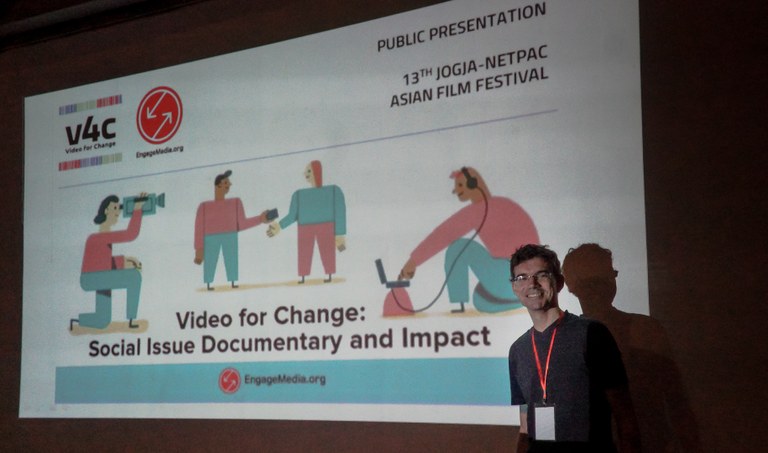
Egbert also stressed that, notwithstanding differences in video for change approaches, there are certain ethical values that all for video change practitioners should respect and uphold. These values range from risk management and inclusion and participation of others to ensuring transparency in expectations and the working process. However, he acknowledged that the implementation of these values is never a one-size-fits-all matter; as all is dependent on risk factors, existing power relations and level of engagement with affected communities.

Before opening the floor for questions, a short video documenting a participatory research was shown. The research is part of Highrise, a long-term collaborative documentary experiment that explores vertical living around the world. It is an excellent example of a participatory process with a strong capacity-building component that led to a positive impact during the research and development stages of a video for change initiative.
At the end of the session, the presenters received several questions, particularly on security. Fortunately, Manu and Thois from Papuan Voice were able to attend the session after their six-city Javanese screening tour. They joined Egbert and Pitra in front, and shared their experiences with regards to the tour and producing issues-based films in Papua. Their stories about dealing with the absence of roads and electricity in several communities, and making the most of simple equipment were inspiring and reminded all those present about the importance of persistence and belief in the process, as contributions to social impact seldom come overnight and are never achieved alone.

Interestingly, a question on how to quickly create more impact was directed to the presenters. Egbert answered explaining that it is more important to be more realistic in setting goals to achieve through the use of video; respectfully advising those who wonder similarly to revisit personal motives and expectations, prior to going out and producing an amazing impactful film.

The session ended with a group photo. Pitra and Egbert were also able to stay around to mingle and discuss with some participants. It was definitely a successful first appearance at JAFF. Hopefully, we will be able to join again next year!
Films shed light on pressing digital rights issues in Myanmar

To commemorate the International Human Rights Day, EngageMedia, along with the Myanmar ICT for Development Organization (MIDO) and Phandeeyar Innovation Lab, organised a film screening and discussion on 16 December 2018 in Yangon. It featured two remarkable short films that showcased the everyday struggles of Myanmar people in fully exercising their human rights online.

This event is a culmination of our collaboration with the movement behind the Myanmar Digital Rights Forum (#digitalrightsMM); bringing in amazing local film-makers: the award-winning Kyal Yi Lin Six and up-and-coming animation and graphic design start-up JOOSK Studios.
“This digital rights film collaboration project channels the power of films to effect change on digital rights, not just for Myanmar people but for all peoples in Southeast Asia,” said Yatanar Htun of MIDO.
Are We Ready?
“Are You Ready?” is a film produced by animation and graphic design start-up JOOSK Studios. It narrates how the Article 66(D) of the 2013 Telecommunications Law has been continuously used by military people and political parties to silence critics and dissenters of the government.

"There have been no effective changes even though Telecommunications Law was amended in 2017. But there were more than 70 cases under the law. Are You Ready reflects the impact of Article 66(d) and it is very helpful to the Telecommunications Law amendment campaigns," said Maung Saung Kha, who was among those who were arrested in 2015 under Article 66(D) for creating and publishing a poem online. He founded Athan, an activist organisation that forwards freedom of expression for the Myanmar people, that just recently won the Human Rights Tulip Award.
It's Time to Talk
Directed by award-winning film-maker Kyal Yi Lin Six, “It’s Time to Talk” visits a day in a life of a female journalist, a Punjabi student-activist and a transgender woman who all have experienced harassment in digital platforms. The film tackles how presumed safe spaces online have become areas for discrimination and harassment.
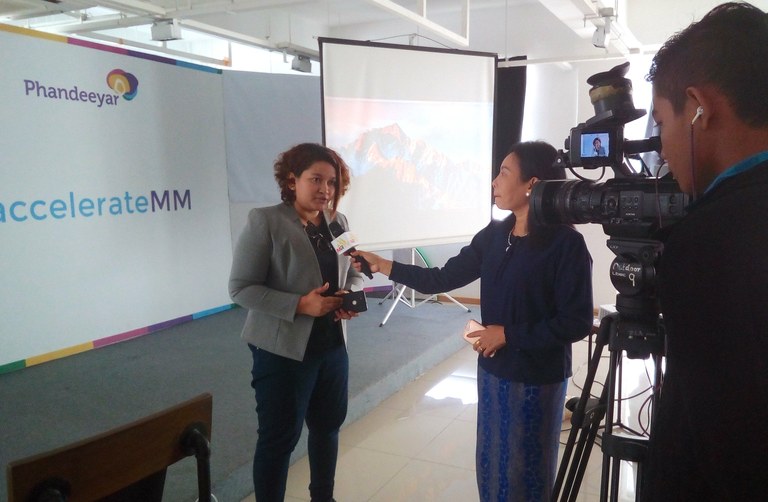
It also outlines possible steps to combat cyber harassment: from changing privacy and account settings on digital platforms to urging key actors to push for changes in culture and behavior.
Myanmar’s Fight for democracy & free speech
“This event is to remind everyone that there are human rights issues that we're all facing when we use the Internet and that we should all work together to address them,” says Ei Myat Noe Khin, Phandeeyar's Digital Rights Manager.
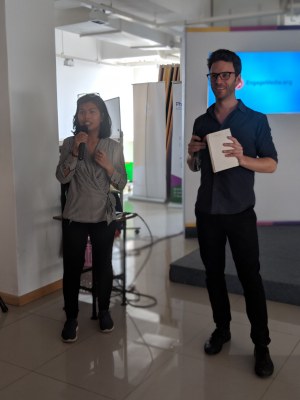
The event, along with the films, hopes to raise public awareness, empower people to speak of their struggles in exercising their human rights online and mobilise more people to call for the immediate attention of the Myanmar government in upholding human rights online and offline.
The film launch event also comes at a critical time, as free speech advocates continue to call for the immediate release of Reuters journalists Wa Lone and Kyaw Soe Oo, who covered the massacre of Rohingya Muslims, a year after their arrest.
-----------------------------------------------------------------------------------------------------------
This film project is made possible by a project grant from the Association for Progressive Communications (APC) and the Swedish International Development Cooperation Agency (SIDA).
The next public screening of the two short films will be during the Myanmar Digital Rights Forum in January 2019. Registration for the Forum can be accessed here. Deadline is on 31 December 2018.
Internet Freedom Is A Basic Human Right
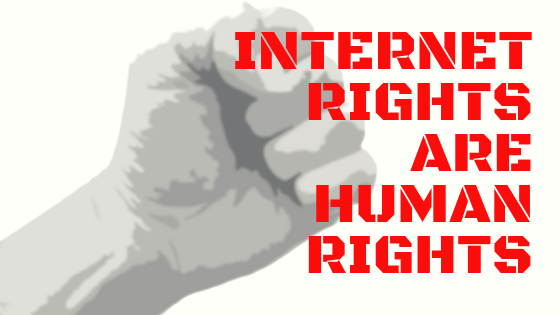
On December 10, we celebrate the International Human Rights Day to commemorate the historic adoption of the Universal Declaration of Human Rights by the United Nations General Assembly on the same day in 1948 in Paris, France.
Today, we will focus on internet rights as a basic human right. For millions of people in the Southeast Asian region, social media, such as Facebook and Twitter, and messaging apps like Line and WhatsApp are extremely popular and have been the main source of information. These platforms tend to be manipulated by certain actors (e.g. government-sponsored troll armies, corporations, political candidates, etc.), which result in disinformation spreading like wildfire. To the authorities, the best response to this is censorship and crackdown affecting freedom of speech of the common people.
Human Rights Online Resolutions
The Association for Progressive Communications, a global network advocating for internet rights, listed United Nations resolutions recognizing human rights online here. As early as October 2009, the Human Rights Council adopted a resolution that recognises the impact of the internet on human rights. It includes the recognition of the importance of all forms of the media, including the internet, in the exercise, promotion and protection of the right to freedom of opinion and expression; calling on States to facilitate equal participation in, access to and use of ICTs, applying a gender perspective.
Since then, numerous resolutions have been produced. In fact, during the 21st and 24th sessions of the Human Rights Council in 2012 and 2013, the States were reminded of their obligation “to respect and fully protect the rights of all individuals to assemble peacefully and associate freely, online as well as offline.” In 2013 as well, the United Nations General Assembly adopted a resolution recognising privacy in the digital age; and even assigning a Special Rapporteur in 2015.
In addition, in July 2018, a resolution entitled “the promotion, protection and enjoyment of human rights on the internet” was again adopted in consensus by the Council.
Diminishing Internet Rights
However, despite the increasing recognition of internet rights, most countries in Asia are still considered either “not free” or “partly free” in the latest Freedom on the Net report. According to the report, there is an observable rise of digital authoritarianism, as governments tighten control over their citizens’ data, and use “fake news” as excuse in order to suppress dissent.
According to the report, there is a decline in internet freedom in Myanmar, India, Cambodia, the Philippines and many more countries around the world. As recently reported, in Myanmar, two Reuters journalists investigating a massacre of Rohingya boys and men were arrested in December 2017, and were later implicated to seven years in prison in August 2018. In addition, the Philippines’s ranking dropped from “free” in 2017 to “partly free” in 2018, due to the increase in libel cases being filed against critics. To add, in India, local internet shutdowns and the proliferation of misinformation and “fake news” across social media can also be observed. In Cambodia, internet freedom restrictions and violations are also on the rise during the leadership of Prime Minister Hun Sen.
The need to fight back
Asia, as one of the world leaders in mobile internet usage with thousands of new technological adopters emerging every day, will be directly affected in the absence of internet rights. This is why there is a pressing need to reiterate that internet rights are a basic human right to be guaranteed by international laws and each country’s constitution. It is high time that human rights defenders in the region to work together to fight for the recognition of internet rights; and pressure authorities to formulate and implement policies in the interest of privacy and free expression.
Internet Rights for Emerging Voices
Projects such as Internews' Internet Rights for Emerging Voices (iREV) was designed to empower local organisations and individuals seeking to advocate for a free, fair and open internet in their communities. iRev shifted Internews’ focus to communities and regions where there is little to no internet freedom advocacy efforts being conducted. In Asia, there are two organisations that are being currently supported by the project: The Bachchao Project in India, and Body & Data in Nepal.
With iREV support, The Bachchao Project aims to focus on building capacity of rural women and fight against internet shutdowns in India; while Body and Data aims to intensify discussions on gender, sexuality and technology with women human rights defenders and tech communities in Nepal.
East Asia civil society strengthens fight against Disinformation
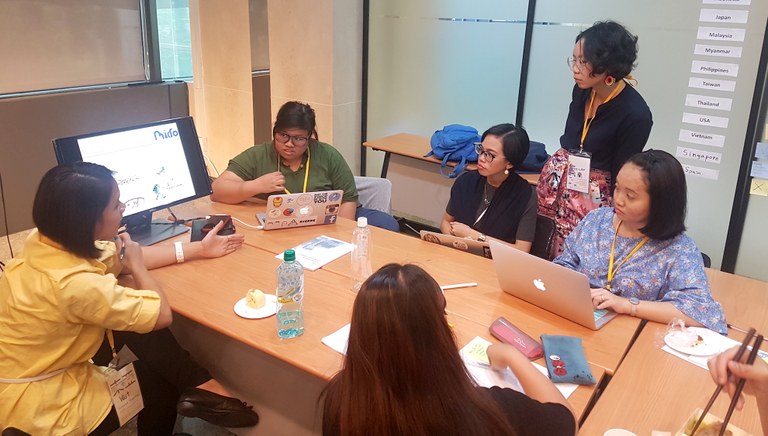
More and more civil society and advocates in East Asia are expressing their concerns on the rise of information manipulation to influence public views and behavior, mislead, incite hatred & fear and even revise factual historical accounts. At the margins of this year's East Asia Democracy Forum in Taipei, the Open Culture Foundation (OCF), together with EngageMedia, the Southeast Asian Press Alliance (SEAPA), and Innovation for Change East Asia gathered digital rights advocates, journalists, bloggers, and citizen journalists from Northeast Asia from China, Japan, South Korea, and Taiwan, and from Southeast Asia from Cambodia, Indonesia, Malaysia, Myanmar, Philippines, Singapore, Thailand, and Vietnam, for a 3-day workshop on June 26-28, 2018, to identify solutions & explore collaborations to combat disinformation in the region.
“We want to discuss the most pressing issue that impacts democracy today, and for us that is the rise of disinformation online. We want to come up with a comprehensive strategy against disinformation,” says Yu Hsuan Chang of OCF. OCF is a Taiwan-based organization supporting local communities advocate for open technologies.
Disinformation in Elections
A lot of countries in East Asia have experienced surge of disinformation on social media, specially during election season. In the Philippines, troll factories were employed to manufacture extremely divisive memes and revisionist historical narratives in the lead-up to the 2016 Presidential elections.
In Malaysia, Maryam Lee, a young feminist activist, recounted being the subject of disinformation during the recently concluded Malaysian general electoral campaign.
Maryam believes that spoiling ballots is a democratic right, and she, along with other activists in Malaysia campaigned for the hashtag #UndiRosak, as they don't want to vote for any of the candidates running that time. She was accused of being financially supported by the then government of Najib Razak. Even media outlets reported that Maryam was being “financially & politically” supported, and there were even posts circulated around that she was paid by Cambride Analytica, the consulting firm accused of illegally sourcing Facebook data using it to influence political campaigns. Maryam adds that the misinformation campaign led to people attacking her based on her gender, even after the elections.
Maryam was one of the participants in the Combatting Disinformation workshop who has pledged to collaborate with civil society across the region to assert that government censorship will never be a solution to address disinformation & misinformation.
During the workshop, there were also groups recommending to engage election monitors to address the disinformation challenge during election campaigns as it can greatly impact the electorates' decision on who to vote come election time. In this joint declaration on fake news, disinformation, & propaganda, released by freedom of expression monitors around the world, including the United Nations Special Rapporteur on Freedom of Expression, media outlets, in line with their watchdog role in society, are also encouraged to consider including critical coverage of disinformation and propaganda during elections.
Fact-checkers vs Disinformation
Fighting disinformation has led to a lot of organizations taking on fact-checking initiatives. There's Fact Check Initiative Japan & Cofacts in Taiwan. In the Philippines, Rappler and Vera Files, both teamed up with Facebook for a fact-checking program to prevent false news from spreading on the social media platform. In Malaysia, there's a very active facebook page called The Malaysian Feminist that fact-checks what is going viral in social media.
GarGar, Project Coordinator of the Myanmar ICT for Development Organization (MIDO), also shares their initiatives on Digital Literacy, and a fact-checking crowdsourcing initiative on social media they call “Real or Not” in Myanmar.
Chihao of Watchout.tw adds their current contribution in the fight against disinformation. “We started as a Congressional watchdog organization. What we do at the core is we fact-check politicians and candidates on their claims and policies, and we find out what they've done in the past based on Congressional records and their past promises. We try to disseminate truthful information to fight disinformation.”
Disinformation Policies & Legislation
One of the key questions in the fight against disinformation is if legislation and/or criminalization the solution. Governments in Southeast Asia are in different stages of developing legislations/policies against what they call “fake news”. In Malaysia, an anti-fake news law was passed just before the elections, and activists and lawyers expressed concern on the speed that it was passed as it was very rushed, and how it will severely undermine right to freedom of expression in the country. In Singapore, according to Law and Home Affairs Minister Shanmugam, the new law to tackle the spread of fake news are expected to be introduced next year.
The Senate Committee on Public Information and Mass Media in the Philippines has also conducted hearings on fake news, which also led to the head of the committee Senator Grace Poe proposing a Senate Bill amending the Code of Conduct for Public Officials and Employees, to penalize those in government who publish and/or spread false news or information in any platform.”
Working Together
A lot of collaborative ideas popped up during the workshop in Taipei proving participants' aspiration to work together even after the workshop. There were groups who want to work on publishing a Study on Disinformation Laws and Policies in Asia that will provide a database of resources on laws, cases, updates, and statistics in the region. There were also groups looking at setting up a disinformation alarm/alert group for building solidarity that will serve as a ‘rapid response’ for journalists and fact checkers assisting each other in combatting disinformation. To address the issue of disinformation during elections, participants were eager in collaborating to monitor disinformation in elections, especially with several elections coming up in the region. There were also activists who are interested to pursue more digital literacy and digital activism trainings focusing on security, as well as looking at getting more converging initiatives of art and technology circles.
EngageMedia plans to support the collaborations identified in the workshop and beyond to also bring to the core the need to expand and strengthen the movement in the region in fighting social injustice and human rights violations online and offline.
Other Readings you may find useful on the topic of Disinformation:
Image credit: EM News
2018 - A Year for Human Rights Defenders

On 10 December 1948, the United Nations General Assembly in Paris promulgated The Universal Declaration of Human Rights as a common standard of achievement for all peoples and all nations.
The Declaration consists of 30 articles elaborating an individual's rights which have been incorporated in subsequent international treaties, contracts, regional human rights instruments, national constitutions, and other laws. The Universal Declaration of Human Rights holds the Guinness World Record as the world’s most translated document, in over 500 languages.
However, the Declaration has been increasingly under attack by governments and other actors trying to reduce it's scope and questioning it's relevance. To highlight what the Universal Declaration means for people in their everyday lives, the UN Human Rights has launched a year-long campaign titled #StandUp4HumanRights which will culminate on 10 December 2018, the day the World will celebrate the Declaration’s 70th anniversary.
The anniversary is a chance for the world to celebrate the gift of the Universal Declaration and to help reaffirm the enduring human rights principles and standards it has helped establish.
Human Rights Defenders In Peril:
In many countries of the world, community leaders, lawyers, journalists, civil society actors and other human rights defenders are facing unprecedented levels of persecution, intimidation and violence as the Universal Declaration of Human Rights is undermined and ignored. Many human rights organizations are prevented from carrying out their work, banned or expelled from certain countries. An increasing number of governments are trying to prevent the International Criminal Court and the Human Rights Council from fulfilling their mission.
To address the concerns of the Human Rights Defenders, the United Nations General Assembly adopted the the ‘United Nations Declaration on Human Rights Defenders’ in 1998. It aims to provide support and protection to human rights defenders (HRDs) in the context of their work and goes beyond the defenders outlining that every citizen has a role in promoting and protecting the human rights of all.
In the recent years, the human rights defenders all over the world were subjected to an increased level of intimidation and threats. In 2017, 197 environmental activists were murdered in the world for their work. In 2016, 281 people killed for defending human rights, up from 156 in 2015.
2018 marks the 20-year anniversary of the United Nations Declaration on Human Rights Defenders. Asian Forum for Human Rights and Development - Forum Asia believes that it is important to raise greater awareness about the UN Declaration On Human Rights Defenders. Particularly in Asia, there is limited access and visibility of the declaration and some people might not be aware that they are considered a ‘human rights defender’, which entitles them specific rights, as well as accords them certain responsibilities.
Forum Asia has published a number of posters to raise the awareness of the declaration in Asia:


The United Nations special rapporteur on the situation of human rights defenders Michel Forst has published a concept note where he stated that the 20th anniversary of the Declaration of the Human Rights Defenders should serve an opportunity to make the Declaration more visible and more accessible to everyone. It should also be occasion to remember and celebrate those who dedicate their lives to the defense of human rights.
Success as Inclusion: Thoughts from the First Voice Indonesia Linking and Learning Event
This report was first published in Voice Blog by Zack Lee, Linking and Learning Officer for Voice Indonesia and The Philippines with inputs from EngageMedia.

Voice Indonesia just had its first annual Linking & Learning (L&L) event last 15-19 April 2018 in Bali. There were 38 participants, including representatives from all 15 Voice Indonesia partners, EngageMedia (the L&L facilitator), and the country team. It was 5 days packed with activities which started in the morning and on most days stretched into the night. Participants had many opportunities to learn from each other as well as share what they know. There were a handful of serious discussions about individual work and how everyone can move forward together. There were also lighter moments of fun and laughter, especially lots of dancing as energizers and icebreakers. Everyone had kind words to say on the last day. One person simply said "Wow!" when asked what their final thoughts were. Another said, "It's like a movie in my head that I keep rewinding over and over again."
Looking back, it would have been presumptuous of me to say that I knew the event would be a success. But I knew it would. This does not mean I did not have my own worries. Certainly far from it. I wasn't sure if the program was coming together. I didn't know if all the details were ironed out. I had many questions in mind because I wasn't involved in the minute details of the planning as I have been before.
I knew the L&L event would be a success because I knew everything works out in the end. We had a great team in EngageMedia who had organized similar eventsbefore. I knew they regularly communicated with grantees through calls and emails explaining what is L&L and what were the intentions behind the event. They continuously asked what the participants wanted to learn and what can the participants share with others. Plus early on, we intentionally adopted an open approach to the event. This meant coming to terms with the sense of ambiguity and imprecision that comes with relying on the participation of everyone involved to set the agenda.
So at the end of the last day, I would have been surprised if the participants did not shed some tears of joy. They did. I would have been surprised if they were not effusive in their praise. They were. What surprised me though was that they felt INCLUDED. One participant said "This is what I want to have in my community." Another said, "This feels like being in a family." Inclusion is a bedrock principle within Voice. We commit to "Leave No One Behind". Yet, what does it mean in practice? More specifically, how did we apply it in planning and organizing the L&L event? Looking back, what were the steps we took to be inclusive?
Inclusive in the Logistics
First is that we took inclusion and accessibility as defining criteria in the planning process. We looked at our current group of grantees and identified what kinds of disabilities did we need to accommodate. We asked EngageMedia to choose a location that was accessible to someone with a mobility impairment. This meant all rooms needed to be accessible by someone using a wheelchair. If not, the hotel needed to provided alternatives such as ramps for participants. We knew that a few participants are deaf or have a hearing impairment. We budgeted for at least 2 sign language interpreters. Similar to oral language interpretations, sign language interpreters need someone to take over in order for them to take breaks and rest.
EngageMedia sent out a survey, which included questions on what other kinds of accommodations we needed to be aware of. Participants were also asked if they have any food restrictions due to health or cultural considerations. There was also a question on blood types in case of emergency situations.
We even had a long discussion about the planned field trip and excursion on the 4th day. After three long days of sometimes very intense sessions, we wanted participants to have a bit of a break and time to bond together outside. For some participants, it would have been their first time to be in Bali. The location needed to be something representative of Bali and Balinese culture, while still being interesting to those who have been there before. Since many locations required some travel and a bit of walking, we considered how strenuous it would be for our older participants. In the end, we decided to visit Uluwatu Temple and have a sunset dinner by the beach in Jimbaran.
Inclusive in the Agenda
Second is that we adopted an open space methodology when it came to designing the agenda. We intended to create a space where the participants were not simply passive recipients of new knowledge. We wanted everyone to see each other as a source of inspiration, someone they can learn from. They did not need to always turn to outside experts for new ideas and solutions. They have each other. Similar with the Voice Inclusion Innovation Indaba and EngageMedia's Coconet Digital Rights Camp, we relied on participants to create the agenda together as a community. They were able to propose ideas for breakout sessions, pitch what it will be about, and vote with their feet on which session they want to participate in.
Starting with the L&L kick-off event last November, we asked participants on multiple occasions what is it they expected and want to learn from the event. More importantly, we also asked what experience, knowledge, and expertise can they share with their fellow participants. Their responses were analysed to identify what were the most commonly mentioned. Participants who could respond to others' needs were encouraged beforehand to propose a session on those topics. There were no pre-determined format leading quite varied and diverse sessions. There were hands-on sessions on shooting and editing videos. There was a small-group discussion on HIV/AIDS. There were demonstrations on basic introductions and the alphabet using Indonesian sign language. Some participants even proposed completely new sessions as collaborations between them and someone with similar ideas. Space was also available for participants to organize sessions at night. A couple of participants organized a film screening on the living conditions of women market porters followed by questions and answers. Others continued or re-did their sessions from the previous days for those who were not able to join.
Partly inspired by the regional workshops on Inclusive Ways of Working, we also wanted to instil the concepts of inclusion and intersectionality in all participants. There were plenary sessions that responded to specific topics a majority of participants requested. Other plenary sessions however, focused on the experiences of a specific target group not as well represented in the current grantees. Presenters and facilitators were asked to present their topic in way that encourages others to see the intersectional nature of discrimination and what solidarity can mean to them.
We were lucky enough that our overall facilitator, Ani Himawati, understood immediately what we wanted to do for the whole event. She was open to different ideas and flexible to the changing dynamics as the event progressed. She invited anyone to lead icebreakers and energizers in between open and plenary sessions. There were lots of dancing involved, one of which Morgan led. His mother, Dewi, said that was the fastest she's seen him become comfortable with a large group of people.
On the last day, a participant nicely summarized the feeling that we were all aiming. He said he felt "there was no gap between us and the facilitator. We were all facilitators."
We can always do better
It was the last day and Oyok from PPSW Pasoendan was going to share her closing words. She held the mic in her hand, said one word and stopped. I could faintly hear a sound and that’s when I realized she was trying to hold back her tears. When she was able to speak, I was surprised. She said, it was the first time she felt included since becoming a mother. We always joked that the L&L event had 38 and a half participants because Oyok brought her 3-month old son, Azka. She said that she was very worried about coming to Bali because she had to bring her son. She was worried that she would not be able to participate or even worse, they would be disrupting the proceedings. I was surprised because I didn't even realize that it was a concern. I saw everyone taking turns watching over or carrying Azka. No one complained or mentioned anything to us about being disrupted. Nobody minded at all.
No matter how much planning we do, determining every detail, luck definitely played a role. We were lucky that everyone immediately took to taking of Azka nor did he even cry during any session. We were lucky enough that everyone was welcoming to each other, no matter their age, background, or ability. We were lucky enough that everyone wanted to participate and were open to learning from each other. We were lucky enough that there was a good balance between genders and ages. A couple of older participants even remarked that there were younger participants present. They were used seeing the same faces every time they attended events and were glad to see a new generation taking up their causes.
As much as we were touched by the kind words people said at the end, we know we could always do a better job of being even more inclusive. We realized that some of our energizers required active movement and listening to music. We neglected to find out how our deaf participants felt during those moments. We took it too lightly that none of the participants had mobility impairments as many of the spontaneously initiated group activities would have been exclusionary.
Yet, to do better, to be more inclusive, luck needs to be playing an even smaller role. We could do better in spontaneity by trying behave more thoughtfully. Inclusion requires us to be intentional in what we do and how we work. If we truly want to leave no one behind then luck needs to be increasingly excluded from our equation of success.


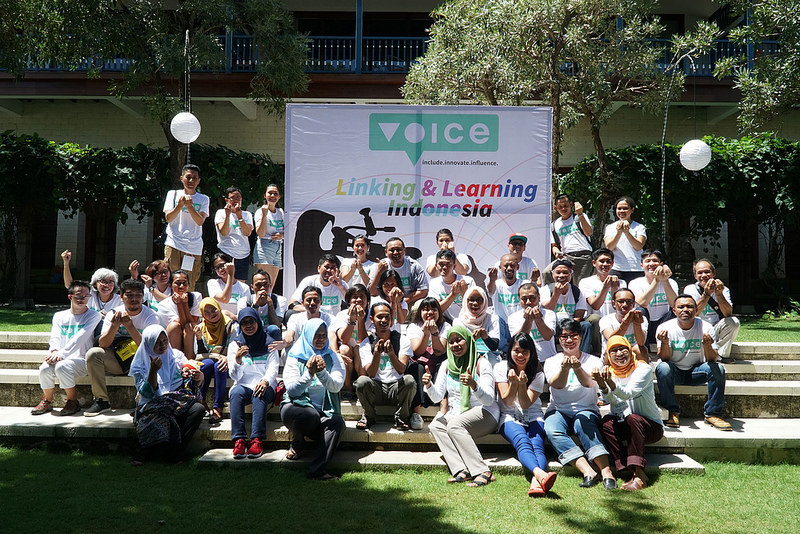

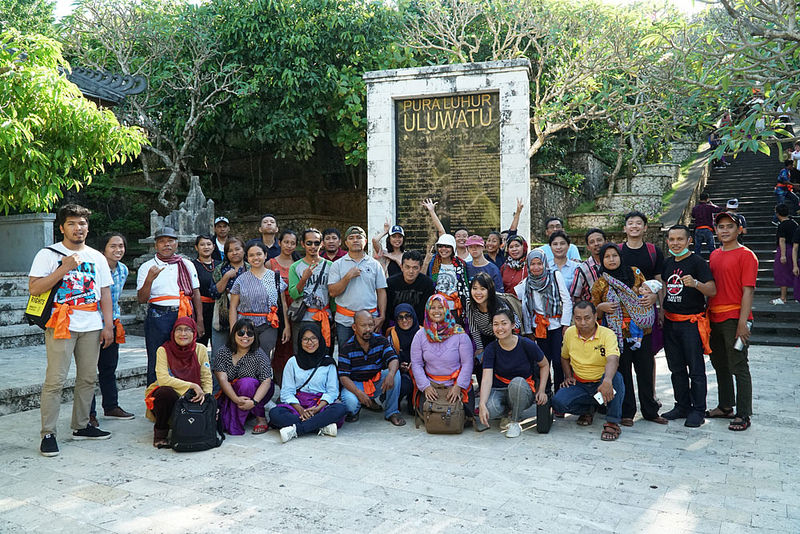
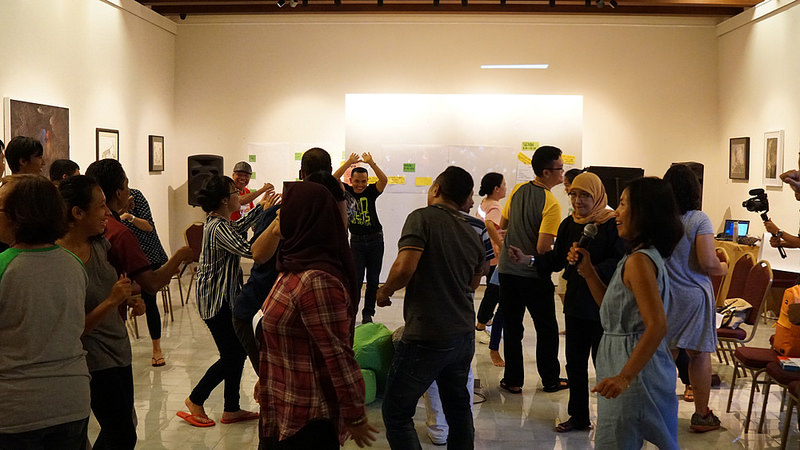
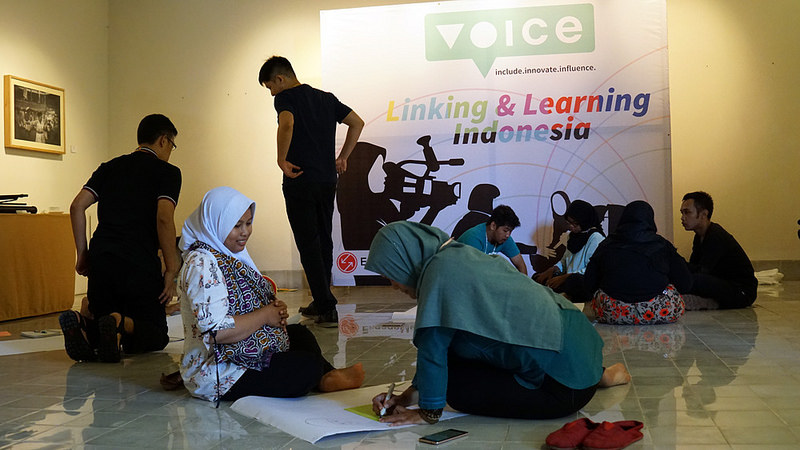
 Subscribe to blog feed
Subscribe to blog feed